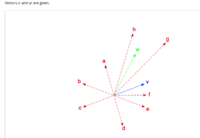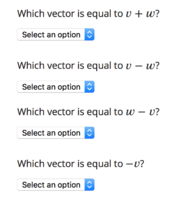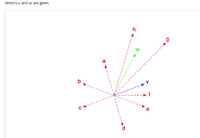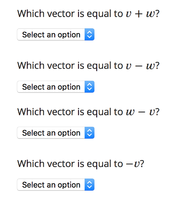You are using an out of date browser. It may not display this or other websites correctly.
You should upgrade or use an alternative browser.
You should upgrade or use an alternative browser.
Vector Problem
- Thread starter TCruz12
- Start date
Hint: Graphical addition/subtraction of vectors use law of parallelograms.
Please show us what you have tried and exactly where you are stuck.Please follow the rules of posting in this forum, as enunciated at:Please share your work/thoughts about this assignment.View attachment 20574View attachment 20573
Thank you for replying! I know that Vector C is equal to -v, since with - vectors, it essentially just goes in the opposite direction. However, I am stuck on the 3 addition and subtraction problems. I do not understand how you get an answer to these without having any numbers.
pka
Elite Member
- Joined
- Jan 29, 2005
- Messages
- 11,971
Unless you post answers (right or wrong) to each of those, here is no way we can(will) help you.
Here is a free one: \(\vec{v}+\vec{w}=\vec{g}\). Can you see why? If so tell us. If not say why!
Unless you post answers (right or wrong) to each of those, here is no way we can(will) help you.
Here is a free one: \(\vec{v}+\vec{w}=\vec{g}\). Can you see why? If so tell us. If not say why!
I'm not sure as to why v + w = g? Could you explain why?
D
Deleted member 4993
Guest
Complete the parallelogram (in the given sketch). You now see:I'm not sure as to why v + w = g? gram.Could you explain why?
v + w = g
- because g makes one of the diagonals of the parallelogram.
pka
Elite Member
- Joined
- Jan 29, 2005
- Messages
- 11,971
Using your posted diagram, take the blue vector to the tip end of the green vector.I'm not sure as to why v + w = g? Could you explain why?
What is the resulting vector?




